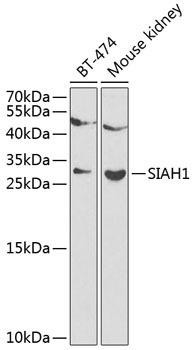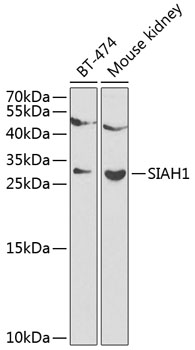Cell Death Antibodies 1
Anti-SIAH1 Antibody (CAB12490)
- SKU:
- CAB12490
- Product Type:
- Antibody
- Reactivity:
- Human
- Reactivity:
- Mouse
- Host Species:
- Rabbit
- Isotype:
- IgG
- Antibody Type:
- Polyclonal Antibody
- Research Area:
- Cell Death
Description
| Antibody Name: | Anti-SIAH1 Antibody |
| Antibody SKU: | CAB12490 |
| Antibody Size: | 20uL, 50uL, 100uL |
| Application: | WB |
| Reactivity: | Human, Mouse |
| Host Species: | Rabbit |
| Immunogen: | Recombinant fusion protein containing a sequence corresponding to amino acids 1-313 of human SIAH1 (NP_001006611.1). |
| Application: | WB |
| Recommended Dilution: | WB 1:500 - 1:2000 |
| Reactivity: | Human, Mouse |
| Positive Samples: | BT-474, Mouse kidney |
| Immunogen: | Recombinant fusion protein containing a sequence corresponding to amino acids 1-313 of human SIAH1 (NP_001006611.1). |
| Purification Method: | Affinity purification |
| Storage Buffer: | Store at -20'C. Avoid freeze / thaw cycles. Buffer: PBS with 0.02% sodium azide, 50% glycerol, pH7.3. |
| Isotype: | IgG |
| Sequence: | MTGK ATPP SLYS WRGV LFTC LPAA RTRK RKEM SRQT ATAL PTGT SKCP PSQR VPAL TGTT ASNN DLAS LFEC PVCF DYVL PPIL QCQS GHLV CSNC RPKL TCCP TCRG PLGS IRNL AMEK VANS VLFP CKYA SSGC EITL PHTE KADH EELC EFRP YSCP CPGA SCKW QGSL DAVM PHLM HQHK SITT LQGE DIVF LATD INLP GAVD WVMM QSCF GFHF MLVL EKQE KYDG HQQF FAIV QLIG TRKQ AENF AYRL ELNG HRRR LTWE ATPR SIHE GIAT AIMN SDCL VFDT SIAQ LFAE NGNL GINV TISM C |
| Gene ID: | 6477 |
| Uniprot: | Q8IUQ4 |
| Cellular Location: | Cytoplasm, Nucleus |
| Calculated MW: | 21kDa/31kDa/34kDa |
| Observed MW: | 31kDa |
| Synonyms: | SIAH1, SIAH1A |
| Background: | This gene encodes a protein that is a member of the seven in absentia homolog (SIAH) family. The protein is an E3 ligase and is involved in ubiquitination and proteasome-mediated degradation of specific proteins. The activity of this ubiquitin ligase has been implicated in the development of certain forms of Parkinson's disease, the regulation of the cellular response to hypoxia and induction of apoptosis. Alternative splicing results in several additional transcript variants, some encoding different isoforms and others that have not been fully characterized. |
| UniProt Protein Function: | SIAH1: E3 ubiquitin-protein ligase that mediates ubiquitination and subsequent proteasomal degradation of target proteins. E3 ubiquitin ligases accept ubiquitin from an E2 ubiquitin- conjugating enzyme in the form of a thioester and then directly transfers the ubiquitin to targeted substrates. Mediates E3 ubiquitin ligase activity either through direct binding to substrates or by functioning as the essential RING domain subunit of larger E3 complexes. Triggers the ubiquitin-mediated degradation of many substrates, including proteins involved in transcription regulation (MYB, POU2AF1, PML and RBBP8), a cell surface receptor (DCC), the cell-surface receptor-type tyrosine kinase FLT3, the cytoplasmic signal transduction molecules (KLF10/TIEG1 and NUMB), an antiapoptotic protein (BAG1), a microtubule motor protein (KIF22), a protein involved in synaptic vesicle function in neurons (SYP), a structural protein (CTNNB1) and SNCAIP. Confers constitutive instability to HIPK2 through proteasomal degradation. It is thereby involved in many cellular processes such as apoptosis, tumor suppression, cell cycle, axon guidance, transcription regulation, spermatogenesis and TNF-alpha signaling. Has some overlapping function with SIAH2. Induces apoptosis in cooperation with PEG3. Upon nitric oxid (NO) generation that follows apoptotic stimulation, interacts with S- nitrosylated GAPDH, mediating the translocation of GAPDH to the nucleus. GAPDH acts as a stabilizer of SIAH1, facilitating the degradation of nuclear proteins. Homodimer. Interacts with group 1 glutamate receptors GRM1 and GRM5. Interacts with DAB1, which may inhibit its activity. Interacts with UBE2E2. Interacts with PEG3. Interacts with GAPDH; leading to stabilize SIAH1. Component of some large E3 complex composed of UBE2D1, SIAH1, CACYBP/SIP, SKP1, APC and TBL1X. Interacts with UBE2I. Interacts with alpha- tubulin. Interacts with PEG10, which may inhibit its activity. Interacts with KHDRBS3. Interacts with SNCAIP and HIPK2. May be induced by p53/TP53, suggesting that it may be required to modulate p53/TP53 response. The relevance of such activity in vivo is however unclear and may not exist. Widely expressed at a low level. Down- regulated in advanced hepatocellular carcinomas. Inhibited by interaction with SNCAIP (isoform 2, but not isoform 1). May be inhibited by interaction with PEG10. Belongs to the SINA (Seven in absentia) family. 3 isoforms of the human protein are produced by alternative splicing. |
| UniProt Protein Details: | Protein type:Apoptosis; Cell development/differentiation; EC 6.3.2.-; EC 6.3.2.19; Ligase; Motility/polarity/chemotaxis; Ubiquitin conjugating system; Ubiquitin ligase Chromosomal Location of Human Ortholog: 16q12.1 Cellular Component: beta-catenin destruction complex; cytoplasm; cytosol; nucleus Molecular Function:identical protein binding; protein binding; protein C-terminus binding; ubiquitin-protein ligase activity; zinc ion binding Biological Process: anatomical structure morphogenesis; apoptosis; axon guidance; cellular protein metabolic process; nervous system development; neuron apoptosis; positive regulation of apoptosis; proteasomal ubiquitin-dependent protein catabolic process; protein catabolic process; protein polyubiquitination; protein ubiquitination during ubiquitin-dependent protein catabolic process; ubiquitin-dependent protein catabolic process |
| NCBI Summary: | This gene encodes a protein that is a member of the seven in absentia homolog (SIAH) family. The protein is an E3 ligase and is involved in ubiquitination and proteasome-mediated degradation of specific proteins. The activity of this ubiquitin ligase has been implicated in the development of certain forms of Parkinson's disease, the regulation of the cellular response to hypoxia and induction of apoptosis. Alternative splicing results in several additional transcript variants, some encoding different isoforms and others that have not been fully characterized. [provided by RefSeq, Jul 2008] |
| UniProt Code: | Q8IUQ4 |
| NCBI GenInfo Identifier: | 46577493 |
| NCBI Gene ID: | 6477 |
| NCBI Accession: | Q8IUQ4.2 |
| UniProt Secondary Accession: | Q8IUQ4,O43269, Q49A58, Q92880, A0FKF3, |
| UniProt Related Accession: | Q8IUQ4 |
| Molecular Weight: | Observed MW: 31kDaCalculated MW: 21kDa/31kDa/34kDa |
| NCBI Full Name: | E3 ubiquitin-protein ligase SIAH1 |
| NCBI Synonym Full Names: | siah E3 ubiquitin protein ligase 1 |
| NCBI Official Symbol: | SIAH1 |
| NCBI Official Synonym Symbols: | SIAH1A |
| NCBI Protein Information: | E3 ubiquitin-protein ligase SIAH1 |
| UniProt Protein Name: | E3 ubiquitin-protein ligase SIAH1 |
| UniProt Synonym Protein Names: | RING-type E3 ubiquitin transferase SIAH1Curated; Seven in absentia homolog 1; Siah-1; Siah-1a |
| Protein Family: | E3 ubiquitin-protein ligase |
| UniProt Gene Name: | SIAH1 |







